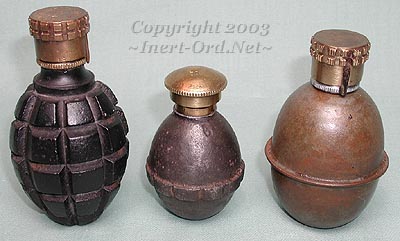
In the 1930's Yugoslavia developed two successive models of grenades, producing a Defensive and Offensive pattern each time. This is the first, the Model 1935.
Also shown is the predecessor, the Model 1917 (center).
The Defensive fragmentation type is at left, made of cast iron with an externally grooved body. The Offensive blast type at right is made of light sheet metal, with no fragmentation matrix. The details of the fuze vary slightly.
 Mod.1917 HE Grenade
Mod.1917 HE Grenade The Mod.1917 is show next to the grenade that inspired it, the Imperial German Eierhandgranate 1917 Na egg grenade.
(The German grenade is far right, with its lead transit plug .)
This cast iron body is marked: " WSW" and the safety cap is dated 1930.
The fuze is a Yugoslavian design. As far as I know this is the only fuze type found on this model.
It was used after WW I and into the beginning of WWII.
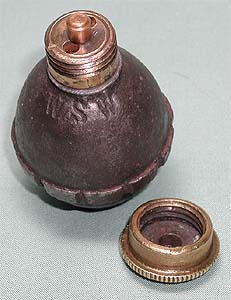
Some features of the Mod.1917 that are common to all the WWII types:
• Percussion Fuze.
• Lead washer between the fuze and the grenade body. (Sometimes leather)
• Brass fuze cap.
• Reverse thread for the fuze body. (Not the Mod. 1917)
• Dual gas vents.
This safety cap has no locking feature and unscrews in the normal manner. Once removed, the percussion cap is struck against a suitable hard object to start the delay.
As a guess, the delay time was probably like the German Egg, 5 seconds.
Mod. 35 Grenade - HE & Fragmentation
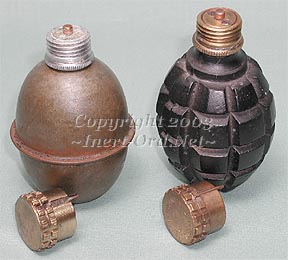
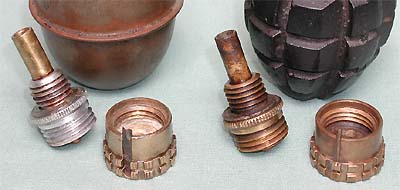
The Model 1935 grenades have this distinctive knurled safety cap, with an external friction locking feature.
During its development, the fuze body construction was changed from brass to aluminum and the locking feature simplified from a crimped steel leaf spring to a brazed brass wire.
I understand that the fuze delay time was 5.6 sec. These two examples are dated 1937 and 1939.
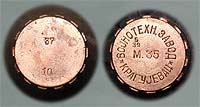 Here are two styles of cap markings. The one on the right is very similar to the markings on the Mod.1917 safety cap.
Here are two styles of cap markings. The one on the right is very similar to the markings on the Mod.1917 safety cap."Military Technical Institution - Kragujevac"
Thanks D.Mitev and Ilija for the translation! (Click on the photo)
